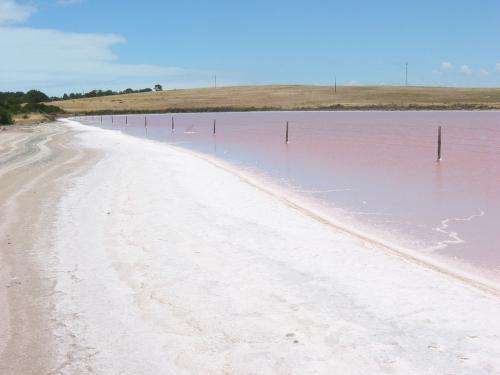Isotopic analysis links Coorong salinity to water regime

Molecular and stable isotopic techniques have been used to examine 5000 years of sedimentary dynamics of the northern Coorong Lagoon, South Australia.
The research involved Curtin University's WA-Organic and Isotope Geochemistry Centre (WA-OIGC), the University of Western Australia and CSIRO.
Part of a terminal lake system at the mouth of the Murray River, the lagoon is vital for migratory and native water birds and is listed under the Ramsar Convention on Wetlands and protected as a national park.
However, the lagoon's hydrology has experienced significant alterations and a marked increase in salinity since the 1950s, when water regulations were imposed on the Murray.
These changes were exacerbated by a major drought from 2000 to 2010, resulting in a severe loss of ecological diversity.
In order to show the impact of human activity on the lagoon, researchers reported the palaeoenvironmental history of the ecosystem, stretching back 5000 years.
"Efficient conservation measures for the Coorong require a profound understanding of the effects of alternations in environmental factors such as water level, salinity or quality of riverine input, all of which have occurred as an immediate result of human water management, on the ecosystem," says co-author Dr Svenja Tulipani.
"Remediation also involves gaining detailed knowledge about ecology and palaeoenvironmental conditions prior to human influence and tracking changes in organic matter sources over time to establish their relationship with those environmental factors."
Analysis reveals river health record
WA-OIGC's Dr Tulipani and Professor Kliti Grice undertook aliphatic and aromatic biomarker analyses to examine changes in the populations of primary producers contributing to sedimentary organic matter, revealing an increase in bacteria and microalgae and decrease in macrophytes since the 1950s—likely due to decreased riverine flow.
They then utilised Compound-Specific Isotopic Analysis of stable hydrogen and carbon isotopes of individual biomarkers to reconstruct salinity variation in the North Lagoon, revealing an overall rise of salinity through the Holocene that spiked dramatically in the 1950s.
"The molecular and isotopic sedimentary record included evidence that human interference with the water regime of the Coorong—namely a drastic reduction of the freshwater inflow due to installation of barrages and extensive water abstractions from the Murray River—was immediately responsible for major changes in the types of primary production, sedimentary organic matter and salinity in the North Lagoon over the past 50 or so years," Prof Grice says.
She says these changes are more pronounced than natural variations over thousands of years.
Researchers hope their findings can help illuminate the impact of human-induced changes on Australian waterways.
More information: Svenja Tulipani, Kliti Grice, Evelyn Krull, Paul Greenwood, Andrew T. Revill, "Salinity variations in the northern Coorong Lagoon, South Australia: Significant changes in the Ecosystem following human alteration to the natural water regime," Organic Geochemistry, Available online 16 May 2014, ISSN 0146-6380, dx.doi.org/10.1016/j.orggeochem.2014.04.013
Provided by Science Network WA




















